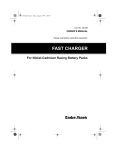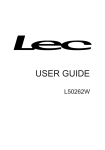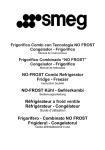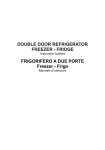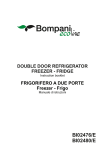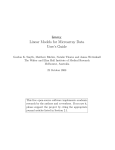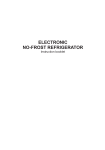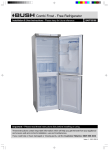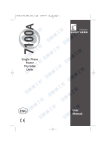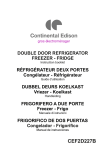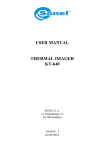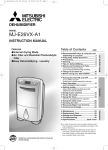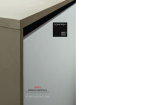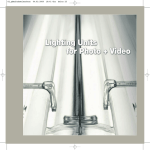Download manuale - Bompani
Transcript
TABLE-TOP REFRIGERATOR AND LARDER Instruction booklet Frigotavolo con o senza Freezer Istruzioni per l'uso BI02472/E Index BEFORE USING THE APPLIANCE ........................................................................2 Safety Instructions ........................................................................................................ 2 Recommendations ....................................................................................................... 3 Installation and Switching On The Appliance .............................................................. 4 Before Switching On ..................................................................................................... 4 THE VARIOUS FUNCTION AND POSSIBILITIES .................................................. 5 Thermostat Setting ....................................................................................................... 5 Accessories .................................................................................................................. 6 “Door Open” Indicator; ........................................................................................................... 6 Making Ice cubes; .................................................................................................................. 6 CLEANING AND MAINTENANCE ...........................................................................7 Defrosting ..................................................................................................................... 7 Replacing The Light Bulb ............................................................................................. 8 TRANSPORTATION AND CHANGING OF INSTALLATION POSITION ................ 9 Changing of Door Opening Direction .......................................................................... 9 BEFORE CALLING YOUR AFTER SALES SERVICE ............................................ 9 THE PARTS OF THE APPLIANCE AND THE COMPARTMENTS ........................ 11 EN - 1 - PART- 1. BEFORE USING THE APPLIANCE Safety Instructions • If the model contains R600a-see name plate inside refrigerator (the coolant isobutane), naturals gas that, is very environmentally friendly but also combustible. When transporting and installing the unit care must be taken to ensure that none of the refrigeration circuit components become damaged. In the event of damage avoid naked flames or ignition sources and ventilate the room in which the unit is placed for a few minutes. • Do not use mechanical devices or other artificial means to accelerate the defrosting process. • Do not use electrical appliances in de the food storage of the appliance. • If this appliance is to replace an old refrigerator with a lock; break or remove the lock as a safety measure before storing it, to protect children while playing might lock themselves inside. • Old refrigerators and freezers contain insulation gases and refrigerant, which must be disposed of properly. Entrust the disposal of a scrap unit categorically to competence of your local waste disposal service and contact your local authority or your dealer if you have any questions. Please ensure that the pipe of work of your refrigerating unit does not get damaged prior to being picked-up by the relevant waste disposal service. IMPORTANT NOTE: Please read this booklet before installing and switching on this appliance. The manufacturer assumes no responsibility for incorrect installation and usage as described in this booklet. Conformity Information • Tropical Class is defined for the environment temperatures between 16°C and 43°C in accordance with the TS EN ISO 15502 Standards. • The appliance is designed in compliance with the EN15502, IEC60335-1 / IEC60335-2-24, 2004/108/EC standards. Please ask your municipal authority about the disposal of the WEEE for the reuse, recycle and recovery purposes. EN - 2 - Recommendations Warning: Do not use mechanical devices or other means to accelerate the defrosting process, other than those recommended by the manufacturer. Do not use electrical appliances inside the food storage compartments of the appliance, unless they are of the type recommended by the manufacturer. Keep ventilation openings, in the appliance enclosure or in the built-in structure, clear of obstruction. Do not damage the refrigerant circuit. • Do not use adapters or shunts, which could cause overheating or burning. • Do not plug old, warped power supply cables. • Do not twist and bend the cables. • Do not allow children to play with the appliance. Children must NEVER sit on drawers or hang from the door. • Do not use sharp metal objects for removing ice on the freezer compartment; they could puncture the refrigerator circuit and cause unrepairable damage to the unit. • Do not plug the power supply with wet hands. • Do not place containers (glass bottles or tin containers) of liquids into the freezer especially gassy liquids as they could cause the container to burst during freezing. • Bottles that contain a high percentage of alcohol must be sealed well and placed vertically in the refrigerator. • Do not touch the cooling surfaces, especially with wet hands as you could be burnt or hurt. • Do not eat ice, which have just been removed from the freezer. • The appliance is not intended for use by people (including children) with reduced physical, sensory or mental capabilities, or lack of experience and knowledge, unless they have been given supervision or instruction concerning use of the appliance by a person responsible for their safety. Children should be supervised to ensure that they don’t play with the appliance. • If the supply cord is damaged it must be replaced by the manufacturer or service agent or similary qualified people in order to avoid a hazard. EN - 3 - Installation and Switching On The Appliance • This appliance is connecting to 220-240V or 200-230V and 50 Hz. Please check nameneplate of appliance and be sure voltage range suitable to your mains voltage. • You can offer help from the service to install and switching on the appliance. • Before making the connection to the power supply, ensure that the voltage on the nameplate corresponds to the voltage of electrical system in your home. • Insert the plug into a socket with an efficient ground connection. If the socket has no ground contact or the plug does not match, we suggest you to call an authorised electrician for assistance. • The plug should be accessible after the appliance is positioned. • Manufacturer is not responsible for failure to complete the ground connection as described in this booklet. • Do not place the appliance in direct sunlight. • Do not use in open air and shall not be exposed to the rain. • Place the refrigerator far from heat sources and in a wellventilated position. The refrigerator should be at least 50 cm from radiators,gas or coal stoves and 5 cm far from electrical stoves. • Keep the top free for at least 15 cm. • Do not place heavy and lots of things on the appliance. • If the appliance is installed next to another refrigerator or freezer, observe a miminum distance of 2 cm to prevent condensation. • Do not put very ( !) hot food or bowl on the top table.It can damage the toptable. • Fit the plastic wall spacers to the condenser at the back of the refrigerator in order to prevent leaning to the wall for good performance. • The appliance must be stand firmly and level on the floor Use levelling-feet to compensate for an even floor. • The outside of the appliance and the accessories inside should be cleaned with a solution of water and liquid soap ; the inside of the appliance with sodium bicarbonate dissolved in lukewarm water. After drying replace all the accessories. Before Switching On • Wait after 3 hours before plugging the appliance in to the power to ensure proper performance. • There can be an odor when you first switch on the appliance. It will disappear after the appliance starts to cool. EN - 4 - PART- 2. THE VARIOUS FUNCTION AND POSSIBILITIES Thermostat Setting • Thermostat automatically regulates the inside temperature of the refrigerator compartment and freezer compartment.By rotating the knob from position 1. to 5., colder temperatures can be obtained. • « 0 » position shows thermostat is closed and no cooling is available. • For short-term storage of food in the freezer compartment, you can set the knob between minimum and medium position.(1-3) • For long-term storage of food in the freezer compartment, you can set knop medium position.(3-4) Note that; the ambiant temperature, temperature of the freshly stored food and how often the door is opened, affects the temperature in the refrigerator compartment. If required,change the temperature setting. • When you first switch on the appliance, for starting a suitable cooling, the appliance should work 24 hours continuously until it cools down to sufficient temperature. • In this time do not open the door so often and place a lot of food inside the appliance. • If the unit is switched off or unplugged, you must allow at least 5 minutes before restarting or re-plugged the unit in order not to damage the compressor. • The freezer of the refrigerator can cool up to -18°C and more. EN - 5 - If super switch is avaible (Only For A+ models): In order to ensure proper operation with an ambient temperature below 20°C, press the button next to the thermostat. Press the button again to turn it off when the temperature is high (above 20°C). Accessories “Door Open” Indicator; • The « Door Open » indicator on the handle shows whether the door has closed properly or whether it is still open. • If the indicator is red, the door is still open. • If the indicator is white, the door is properly closed. • Observe that the freezer’s door should always be kept closed. This will prevent food products from defrosting; it will avoid heavy ice and frost build-up inside the freezer and an unnecessary increase in energy consumption. Making Ice cubes; Ice tray ; • Fill the ice tray with water and place in freezer compartment. • After the water completely turned into ice, you can twist the tray as shown below to get the ice cube. EN - 6 - PART- 3. CLEANING AND MAINTENANCE • Disconnect unit from the power supply before cleaning. • Do not clean the appliance by pouring water. • The refrigerator compartment should be cleaned periodically using a solution of bicarbonate of soda and lukewarm water. • Clean the accessories seperately with soap and water Do not clean them in the washing machine. • Do not use abrasive products, detergents or soaps.After washing, rinse with clean water and dry carefully. When the cleaning operations have been completed reconnect the plug of the unit with dry hands. • You should clean the condenser with broom at least twice a year in order to provide energy saving and increase the productivity. Defrosting For Larders(coolers) ; • Defrosting occurs automatically in refrigerator compartment during operation ; the defrost water is collected by the evaporating tray and evoparates automatically. • The evaporating tray and the defrost water drain hole should be cleaned periodically with defrost drain plug to prevent the water from collecting on the bottom of the refrigerator instead of flowing out. • You can also pour ½ glass of the water to drain hole to clean inside. EN - 7 - For 2 star and 4 star model Refrigerators; The frost, accumulated in the freezer compartment, should be removed periodically. The freezer compartment should be cleaned in the way as the refrigerator compartment, with the defrost operations of the compartment at least twice a year. For this; • The day before you defrost, set the thermostat dial to 5. position to freeze the foods completely. • During defrosting, frozen foods should be wrapped in several layers of paper and kept in a cool place. The inevitable rise in temperature will shorten their storage life. Remember to use these foods within a relatively short period of time. • Switch the refrigerator off at the socket outlet and pull the main plug • Leave the door open and to accelerate the defrosting process one or more basins of warm water can be placed in the freezer compartment. • Dry the inside of the unit and water tray, refit the tray plug and set the thermostat knob to 5 position. Replacing The Light Bulb When replacing the light of the refrigerator compartment; 1. Unplug the unit from the power supply, 2. Press the hooks on the sides of the light cover top and remove the light cover 3. Change the present light bulb with a new one of not more than 15 W. 4. Replace the light cover and after waiting 5 minutes plug the unit. EN - 8 - PART- 4. TRANSPORTATION AND CHANGING OF INSTALLATION POSITION Transportation and Changing of Installation Position • The original packages and foamed polystyrene (PS) can be concealed if required. • In transportation the appliance should be tied with a wide stripe or a strong rope. The rules written on the corrugated box must be applied while transporting. • Before transporting or changing old installation position, all the moving objects (ie,shelves,crisper…) should be taken out or fixed with bands in order to prevent the shake. Changing of Door Opening Direction (In some models) In case you need to change door-opening direction, please consult the domestic after sales service. PART- 5. BEFORE CALLING YOUR AFTER SALES SERVICE If your refrigerator is not working properly,it may be a minor problem, therefore check the following, before calling an electrician to save time and money. What to do if your refrigerator does not operate ; Check that ; • There is no power, • The general switch in your home is not disconnected , • The thermostat setting is on « 0 » position, • The socket is not sufficient. To check this, plug in another appliance that you know which is working into the same socket. What to do if your refrigerator performs poorly ; Check that ; • You have not overloaded the appliance , • The doors are closed perfectly , • There is no dust on the condenser , • There is enough place at the rear and side walls. EN - 9 - If there is noise ; The cooling gas which circulates in the refrigerator circuit may make a slight noise(bubbling sound) even when the compressor is not running. Do not worry this is quite normal. If these sounds are different check that ; • The appliance is well leveled , • Nothing is touching the rear , • The stuffs on the appliance are vibrating. If there is water in the lower part of the refrigerator ; Check that ; The drain hole for defrost water is not clogged(Use defrost drain plug to clean the drain hole) If your fridge is not cooling enough; Your fridge is designed to operate in the ambient temperature intervals stated in the standards, according to the climate class stated in the information label. We do not recommend operating your fridge out of stated temperatures value limits in terms of cooling effectiveness. Climate Class T ST N SN Ambient Temperature (°C) Between 16 and 43 (°C) Between 16 and 38 (°C) Between 16 and 32 (°C) Between 10 and 32 (°C) Recommendations • In order to increase space and improve the appearance,the « cooling section » of refrigerators is positioned inside the back wall of the refrigerator compartment. When the appliance is running, this wall is covered with frost or water drops,according to weather the compressor is running or not. Do not worry. This is quite normal. The appliance should be defrosted only if an excessively thick layer forms on the wall. • If the appliance is not used for long time (for example during the summer holidays)set te thermostat knob to « 0 » position. Defrost and clean the refrigerator leaving the door open to prevent the formation of midew and smell. EN - 10 - PART- 6. THE PARTS OF THE APPLIANCE AND THE COMPARTMENTS This presentation is only for information about the parts of the appliance. Parts may vary according to the appliance model. 1) Top Table (head panel) 8) Bottle Shelf 2) Freezer Comprtment 9) Egg Shelf 3) “Door Open” Indicator 10) Egg Holder 4) Refrigerator Shelf 11) Top Shelf 5) Crisper Cover (Safety Glass**) 12) Top Shelf Cover 6) Crisper 13) Thermostat Box 7) Leveling Feet 14) Ice Tray EN - 11 - Indice PRIMA DI METTERE IN FUNZIONE L’APPARECCHIO ....................................... 13 Informazioni di sicurezza ............................................................................................ 13 Raccomandazioni ....................................................................................................... 14 Montaggio E Messa In Funzione Dell’apparecchio ................................................... 15 Prima Della Messa In Funzione ................................................................................. 15 FUNZIONI E POSSIBILITA’ .................................................................................. 16 Regolazione Del Termostato ..................................................................................... 16 Accessori .................................................................................................................... 17 Indicatore “porta aperta” ..................................................................................................... 17 Per Fare Dei Cubetti Di Ghiaccio .......................................................................................... 17 PULIZIA E MANUTENZIONE ................................................................................ 18 Sbrinamento ............................................................................................................... 19 Sostituzione Della Lampadina .................................................................................. 20 TRASPORTO E SPOSTAMENTO DELL’APPARECCHIO .................................... 20 Modifica del senso di apertura della porta ................................................................ 20 PRIMA DI CHIAMARE IL SERVIZIO .................................................................... 21 DEGLI ACCESSORI DEL FRIGORIFERO ............................................................ 23 IT - 12 - PARTE 1. PRIMA DI METTERE IN FUNZIONE L’APPARECCHIO Informazioni di sicurezza • Al momento del trasporto e dell’installazione dell’apparecchio prestare attenzione affinché nessuno dei componenti del circuito refrigerante resti danneggiato. • Se si possiede un vecchio frigorifero munito di chiusura, rompere o rimuovere questa chiusura prima di smaltire il frigorifero, in quanto i bambini potrebbero rimanervi rinchiusi durante i loro giochi e causare un incidente. • I vecchi frigoriferi e congelatori contengono materiali isolanti e un gas refrigerante con CFC. Fare quindi attenzione a non danneggiare l’ambiente quando si smaltisce il vecchio frigorifero. Note importanti: • Qualora il modello contenga isobutano (R600a) come refrigerante - vedere la targhetta all’interno del frigorifero - prestare attenzione al momento del trasporto e dell’installazione dell’apparecchio affinché nessuno degli elementi del circuito refrigerante dell’apparecchio venga danneggiato. • L’isobutano è un gas naturale innocuo per l’ambiente ma è infiammabile. In caso di perdite a seguito di danneggiamento degli elementi del circuito refrigerante, allontanare il frigorifero da fiamme vive o fonti di combustione e aerare per alcuni minuti il locale in cui si trova il frigorifero. • Leggere attentamente questo libretto delle istruzioni prima di installare e porre in funzione l’apparecchio. La nostra azienda non sarà responsabile dei danni che possano derivare da un utilizzo non corretto. • Osservare tutte le istruzioni sull’apparecchio e il libretto delle istruzioni che dovrà essere conservato in luogo sicuro per risolvere gli eventuali problemi che sorgeranno in futuro. • Questo apparecchio è stato progettato per il suo uso esclusivamente domestico e con finalità ben precise. Non è idoneo all’uso commerciale o comune. L’eventuale uso diverso da quello consentito sarà causa di annullamento della garanzia e la nostra azienda non sarà responsabile degli eventuali danni che ne potranno derivare. • Questo apparecchio è stato progettato per il suo uso esclusivamente domestico ed è idoneo solo al raffreddamento / alla conservazione degli alimenti. Non è idoneo all’uso commerciale o comune e/o alla conservazione di sostanze diverse dagli alimenti. La nostra azienda non sarà responsabile degli eventuali danni che potranno derivare da un uso scorretto dell’apparecchio. Questo apparecchio dispone di contrassegno ai sensi della direttiva europea 2002/96/CE in materia di apparecchi elettrici ed elettronici (waste electrical and electronic equipment - WEEE). Questa direttiva definisce le norme per la raccolta e il riciclaggio degli apparecchi dismessi valide su tutto il territorio dell'Unione Europea. IT - 13 - Raccomandazioni Attenzione: non usare dispositivi meccanici o altri strumenti artificiali per accelerare il processo di sbrinamento. Non usare dispositivi elettrici nello scomparto di conservazioni cibi del dispositivo. Tenere libere le aperture di ventilazione del dispositivo. Non danneggiare il circuito refrigerante del frigo. • Non usare adattatori o deviazioni che possono creare aumenti di temperatura o incendi. • Non collegate vecchi e deformati cavi di alimentazione. • Non piegate e non tirate mai i cavi. • Non permettete ai bambini di giocare con l’apparecchio - i bambini non devono mai tirare o appendersi alla maniglia con l’aiuto di una sedia. • Per rimuovere il ghiaccio formatosi nel reparto freezer non usate oggetti di metallo che potrebbero rovinare le parti del congelatore, provocando danni irreparabili. Per fare ciò usate un raschietto di plastica. • Non inserite la spina nella presa con le mani bagnate. • Per evitare il pericolo di esplosioni di bottiglie in vetro o scatole che contengono in particolare dei liquidi gassosi non metteteli nel congelatore durante la fase di raffred-damento. • Le bottiglie che contengono una elevata percentuale di alcool devono essere ben sigillate e piazzate verticalmente nel frigorifero. • Non toccate la superficie refrigerante con le mani umide per evitare scottature o ferite. • Non mangiate il ghiaccio che è stato rimosso dal freezer. • Questo apparecchio non deve essere usato da persone (inclusi i bambini) con capacità fisiche, sensoriali o mentali ridotte, o che mancano di esperienza e conoscenza, a meno che non abbiano ricevuto una supervisione o istruzioni sull’uso dell’apparecchio da parte di una persona responsabile della loro sicurezza. I bambini devono ricevere supervisione per assicurarsi che non giochino con l’apparecchio. • Se il cavo di alimentazione viene danneggiato, deve essere sostituito dal produttore o da un tecnico per l’assistenza o una persona addetta. IT - 14 - Montaggio E Messa In Funzione Dell’apparecchio • Questo apparecchio è costruito per funzionare con la tensione da 220-240 V e 50 Hz. • Prima di effettuare il collegamento, accertatevi che la tensione della vs. casa sia identica a quella sull’etichetta dell’apparecchio. • Se la presa di corrente non è compatibile con la spina del frigorifero, rimpiazzate la spina con una compatibile (almeno 16A). • Inserite la spina nella presa di corrente con un buon isolamento verso terra.Se la presa di corrente non ha messa a terra, vi suggeriamo di chiamare un elettricista per l’assistenza. • La vaschetta dell’acqua (per il 127 lt) deve essere nella sua esatta sede. Non rimuovetela! • Il costruttore non è responsabile per difetti derivati dalla mancanza della messa a terra. • Non esponete l’apparecchio direttamente ai raggi solari • Non usare all’aperto e non esporre alla pioggia il frigorifero. • Il vostro frigorifero dovrà essere installato lontano da tutte le sorgenti di calore; prevedere una buona ventilazione d’aria e una distanza di 50 cm quando si trova in prossimità di radiatori, stufe a gas e a carbone, e di minimo 5 cm quando si tratta di stufe elettriche • Installate il vs. frigorifero in modo da lasciare uno spazio d15 cm sotto il basamento • Non appoggiate pesi sull’apparecchio. • Nel caso in cui il frigorifero è installato vicino ad un altro frigorifero o congelatore, prevedere una distanza di almeno 2 cm per evitare la condensa. • Non mettere cibo caldo o bollente nel frigorifero. Questo potrebbe danneggiare l’apparecchio. • Fissate nel retro del frigorifero gli spaziatori di plastica fra il condensatore e la parete in modo da ottimizzare il funzionamento dell’apparecchio. • L’apparecchio deve essere posizionato su di una superficie piana. In caso di superfici inclinate, utilizzate i due piccoli frontali per compensare eventuali dislivelli. • Pulite gli accessori esterni ed interni con acqua tiepida con aggiunta di un cucchiaio di bicarbonato. Rimettete al loro posto tutti gli accessori dopo averli asciugati molto bene. Prima Della Messa In Funzione • Allo scopo di garantire un’ottima prestazione, attendete 3 ORE prima di collegare l’apparecchio alla rete. • Potrebbe esserci odore quando lo accendete per la prima volta, questo sparirà quando comincerà la refrigerazione. IT - 15 - PARTE 2. FUNZIONI E POSSIBILITA’ Regolazione Del Termostato • La temperatura interna del congelatore e del frigorifero è regolata automaticamente dal termostato. Allo scopo di avere una temperatura più bassa, ruotare la manopola a partire dalla posizione 1 verso la posizione 5. • Per la conservazione degli alimenti nel congelatore per un breve periodo, mettere la manopola tra 1 e 3. • Per la conservazione degli alimenti nel congelatore per un lungo periodo, mettere la manopola nella posizione MEDIA.(3-4) • La posizione “0” indica che il termostato è spento e non c’è refrigerazione. • Attenzione; la temperatura esterna, la quantità degli alimenti da conservare e la frequente apertura della porta influenzano la temperatura interna del congelatore. In caso di bisogno modificare la regolazione della temperatura. • Quando l’apparecchio viene acceso per la prima volta, bisogna farlo funzionare per 24 ore per raggiungere la temperatura sufficiente per l’inizio della refrigerazione. • Durante questo periodo non aprite sovente la porta e non mettete troppi alimenti. • Se l’apparecchio si spegne o è scollegato, non rimettetelo in funzione se non dopo 5 minuti-ciò potrebbe danneggiare il compressore • il congelatore del frigorifero può raffreddare fino a –18° C e oltre. IT - 16 - Se l'interruttore super è disponibile (per modelli da A+) Al fine di garantire il funzionamento appropriato con una temperatura ambiente inferiore a 20°C, premere il pulsante vicino al termostato. Premere nuovamente il pulsante per spegnere quando la temperatura è alta (sopra i 20°C). Accessori Indicatore “porta aperta” • L’indicatore «porta aperta» situato sulla maniglia indica se la porta è stata chiusa bene oppure se è ancora aperta. • Se l’indicatore è rosso, la porta è ancora aperta. • Se l’indicatore è verde, la porta è stata chiusa correttamente. • Controllare che la porta del congelatore sia sempre ben chiusa. Questo eviterà lo scongelamento degli alimenti; impedirà anche la formazione di blocchi di ghiaccio e brina all’interno del congelatore ed un inutile aumento del consumo energetico. Per Fare Dei Cubetti Di Ghiaccio • La Vaschetta Del Ghiaccio ; • Riempite la vaschetta del ghiaccio con acqua e mettetelo nel reparto congelamento. • Dopo che l’acqua è diventata completamente ghiacciata, potete girare la vaschetta del ghiaccio come mostrato sotto per ottenere i cubetti. IT - 17 - PARTE 3. PULIZIA E MANUTENZIONE • Prima della pulizia, staccare l’apparecchio dalla rete. • Non pulite l’apparecchio versando dell’acqua. • Pulite la parte della refrigerazione periodicamente, versando dell’acqua tiepida con l’aggiunta di bicarbonato di sodio. • Pulite gli accessori separatamente con acqua e sapone - non metteteli nella lavastoviglie • Non usate detergenti, prodotti abrasivi o sapone. Dopo il lavaggio, risciacquate con acqua pulita e asciugateli molto bene. Quando l’operazione di pulizia è terminata, collegate la spina alla presa di corrente con le mani asciutte. • Per economizzare energia e il rendimento dell’apparecchio, pulite il condensatore due volte all’anno con una scopa elettrica. IT - 18 - Sbrinamento • L’operazione viene fatta automaticamente quando il frigorifero è in funzione. L’acqua dello Sbrinamento è raccolta in un vassoio di evaporazione ed evapora spontaneamente. • Per evitare l’accumulo di acqua, che può cadere all’esterno, il vassoio di evaporazione e il buco del Canale di scarico dell’acqua prodotta dallo sbrinamento devono essere puliti periodicamente. • Potete anche versare mezzo bicchiere di acqua nel buco del canale dell’acqua per pulire internamente. Per il frigorifero da 2*, 4* Il ghiaccio che ricopre il ripiano del reparto freezer deve essere rimosso periodicamente (usate un raschietto di plastica). Il congelatore deve essere pulito, nello stesso modo del frigorifero, almeno due volte all’anno. Per questo: • il giorno prima dello sbrinamento mettete il termostato nella posizione 5. • Durante l’operazione di sbrinamento, tutti gli alimenti congelati devono essere avvolti in fogli sottili di plastica e custoditi in un posto freddo. • Il caldo che è in aumento potrebbe deteriorare gli alimenti e pertanto si raccomanda di consumarli il più presto possibile. • Lasciate aperta la porta e accellerate il processo di sbrinamento ponendo una o più bacinelle di acqua tiepida nel comparto freezer. • Pulite l’interno e la vaschetta dell’acqua, rimettete il tappo della vaschetta e rimettete il termostato nella posizione 5. IT - 19 - Sostituzione Della Lampadina Quando sostituite la lampadina nella zona frigorifero; 1. Staccate la spina di corrente 2. Aprite i ganci del coperchio della lampada e fatela uscire 3. Sostituite la lampadina con un’altra che non sia superiore a 15 w 4. Rimettete al suo posto il coperchio, attaccate il frigorifero dopo 5 minuti. PARTE 4. TRASPORTO E SPOSTAMENTO DELL’APPARECCHIO Trasporto e spostamento dell’apparecchio • L’imballo originale ed il polistirolo espanso (PS) possono essere conservati, se necessario. • Durante il trasporto l’apparecchio deve essere legato con un largo nastro o una fune resistente. Durante il trasporto devono essere applicate le norme indicate sulla scatola di cartone. • Prima del trasporto o dello spostamento dell’apparecchio dalla sua vecchia sistemazione, tutti gli oggetti mobili (ad es. ripiani, contenitore frutta-verdura) devono essere tolti o fissati con strisce adesive per prevenire gli urti. Modifica del senso di apertura della porta (In alcuni modelli) Se si presenta la necessità di modificare il senso di apertura della porta, vi preghiamo di consultare il servizio assistenza. IT - 20 - PARTE 5. PRIMA DI CHIAMARE IL SERVIZIO Se il vostro frigorifero non funziona correttamente, potrebbe essere un problema minore. Controllate i seguenti punti prima di chiamare il servizio assistenza. Se il frigorifero non funziona: • può mancare corrente • il fusibile può essere bruciato • il termostato è posizionato sullo “O” • la spina può essere inserita male • La presa di corrente dove è inserita la spina può essere danneggiata, per essere sicuri di ciò collegate un altro apparecchio elettrico. Cosa fare se il frigorifero ha un basso rendimento: • il frigorifero può essere sovraccarico • le porte possono essere chiuse in modo non corretto • il condensatore può essere ricoperto di polvere • potrebbe essere troppo poca la distanza dietro il frigorifero Se c’è qualche rumore ; Il gas refrigerante che circola nel frigorifero genera un leggero rumore, anche se il compressore non funziona. Tutto ciò è del tutto normale. Se avvertite rumori diversi controllate che • l’apparecchio sia perfettamente in piano • può esserci dietro qualche cosa che tocca • può esserci qualche cosa nel frigorifero che vibra Se trovate dell’acqua nella porta del frigorifero ; controllate che ; Il foro del canale dell’acqua di sbrinamento non sia otturato Se il frigo non raffredda abbastanza: Il frigo è progettato per funzionare con intervalli a temperatura ambiente stabiliti negli standard in base alla classe climatica indicata nell’etichetta informativa. Si sconsiglia in funzionamento con temperature esterne ai limiti stabiliti in termini di efficacia di raffreddamento. Classe T ST N SN IT - 21 - Temperatura ambiente (°C) Tra 16 e 43 (°C) Tra 16 e 38 (°C) Tra 16 e 32 (°C) Tra 10 e 32 (°C) Raccomandazioni • La parte di congelazione del frigorifero deve essere ben chiusa. Quando il frigorifero funziona può succedere la formazione di ghiaccio. Non è un grosso problema. Nel caso che si formi uno strato di ghiaccio (maggiore di 5 mm) staccate il frigorifero fino a che il ghiaccio sparisce. In questo caso bisogna nuovamente regolare il termostato. • Nel caso in cui non utilizzate il frigorifero per un lungo periodo, mettete il termostato nella posizione “O”. Pulite il frigorifero e allo scopo di evitare formazione di muffa e odori lasciate la porta aperta. Staccate la spina di corrente per la pulizia e quando lasciate la porta aperta. Dichiarazioni di conformità • La classe Tropical è progettata per temperature comprese tra 16°C e 43°C in conformità alla norma TS EN ISO 15502. • L’apparecchio è stato concepito in conformità con le norme EN15502, IEC60335-1/ IEC60335-2-24, 2004/108/EC. IT - 22 - PARTE 6. DEGLI ACCESSORI DEL FRIGORIFERO Questa presentazione è puramente informativa sui componenti dell’apparecchio. I componenti potrebbero variare secondo il modello dell’apparecchio. 1) TOP TABLE (PANNELLO) 2) COMPARTO FREEZER 3) "PORTA APERTA" INDICATORE 4) RIPIANO DEL FRIGORIFERO 5) COPERCHIO CASSETTI(VETRO DI SICUREZZA 6) CASSETTI 7) PIEDINI PER LIVELLAMENTO 8) CONTENITORE PER BOTTIGLIE 9) CONTENITORE PER UOVA 10) CONTENITORE UOVA 11) PER BURRO E FORMAGGIO 12) COPERCHIO INIZIO RIPIANO 13) TERMOSTATO 14) VASSOIO DEL GHIACCIO IT - 23 - 52070095





























